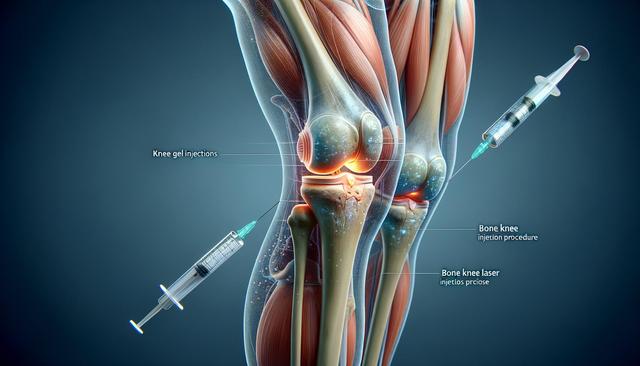Understanding Knee Gel Injections and Their Role in Pain Management
Knee gel injections, also known as viscosupplementation, involve the administration of a gel-like substance—typically hyaluronic acid—directly into the knee joint. This treatment is commonly used in cases of osteoarthritis to supplement the lubrication and cushioning of the knee. Patients often search for “Knee Gel Injections Near Me” when looking for local options to manage their knee discomfort without resorting to surgery. The injection acts as a shock absorber and lubricant, which may help reduce pain and improve mobility.
Knee gel injections are typically recommended for individuals experiencing mild to moderate osteoarthritis. These injections are considered a non-invasive option and are often used when other treatments, such as physical therapy or oral medications, have not provided sufficient relief. Some of the benefits include:
- Reduced inflammation within the joint
- Improved joint movement and flexibility
- Minimal downtime after the procedure
It’s important to note that the “Knee Gel Injections Cost” can vary depending on location, the healthcare provider, and insurance coverage. Patients should consult with their healthcare provider to determine if this treatment is appropriate for their specific condition and what financial considerations may apply.
Exploring Bone Knee Laser Injections as a Modern Alternative
Bone knee laser injections are an evolving treatment approach designed to target knee pain associated with more advanced joint degeneration. Often referred to as “Laser Injections for Bone on Bone Knee,” this method utilizes laser-guided technology to enhance the precision of the injection placement. This is particularly valuable for individuals who have reached a stage where cartilage has significantly worn down, and traditional methods offer limited relief.
Laser-assisted techniques may improve the efficacy of intra-articular injections by ensuring that the therapeutic agents are delivered exactly where they’re needed. This can be beneficial for patients who might not be ideal candidates for surgery but still require targeted pain management strategies. Some advantages include:
- Increased accuracy of injection placement
- Potential for improved long-term outcomes
- Minimized risk of damaging nearby tissues
Although still under clinical evaluation in many settings, the combination of laser technology with traditional injection therapies is gaining interest among both providers and patients. As with any medical procedure, it’s essential to discuss possible risks and benefits with a qualified medical professional.
Knee Injections for Arthritis: A Versatile Treatment Approach
Arthritis in the knee can significantly impact daily life, making even basic movements painful. “Knee Injections for Arthritis” are widely used to help manage symptoms such as swelling, stiffness, and persistent joint pain. The types of injections available include corticosteroids, hyaluronic acid (gel), platelet-rich plasma (PRP), and more recently, regenerative medicine options like amniotic fluid or placental tissue derivatives.
Among regenerative options, the “Epifix Injection for Knee Pain” has been noted for its potential to support tissue healing and reduce inflammation. Derived from processed human amniotic membrane, this type of injection is typically administered under sterile conditions by a trained professional. It’s often considered when other methods have not provided sufficient relief or when patients are looking for alternatives to long-term medication use.
Common benefits of these injections include:
- Reduced reliance on oral medications
- Improved knee joint function
- Fewer side effects compared to systemic therapies
When considering knee injections for arthritis, it’s crucial to assess the specific type of arthritis and the stage of joint degradation. Personalized treatment plans developed with healthcare providers usually yield the most effective results.
Evaluating the Cost and Accessibility of Knee Injection Treatments
One of the most frequently asked questions by patients considering these treatments is about the “Knee Gel Injections Cost.” Prices can vary significantly depending on several factors such as geographic location, insurance coverage, and the specific type of injection used. For example, regenerative options like the “Epifix Injection for Knee Pain” may not be covered by all insurance plans, potentially increasing out-of-pocket expenses.
When searching for treatment options, patients often begin with a phrase like “Knee Gel Injections Near Me” to identify local providers. Many clinics offer consultations to discuss treatment suitability and cost transparency, which is a critical step in making an informed decision. It’s also worth comparing different clinics and asking about bundled pricing or payment plans, especially if multiple sessions are required.
To better understand the potential costs, patients should consider:
- Whether initial consultation fees are included
- The number of injections recommended
- Follow-up care and monitoring costs
Discussing financial aspects with both the healthcare provider and the insurance company can help avoid unexpected expenses and ensure a smoother treatment journey.
Choosing the Right Injection for Knee Pain Relief
With a range of options available, choosing the most appropriate “Injection for Knee Pain” depends largely on the individual’s condition and health goals. Whether it’s gel injections for mild arthritis or laser-assisted techniques for advanced degeneration, these treatments provide a spectrum of solutions for managing chronic knee issues.
Healthcare providers typically evaluate:
- Severity of cartilage loss
- Patient lifestyle and activity level
- Previous treatment history
- Overall health and potential contraindications
For many patients, a combination of treatments might offer the most relief. For instance, a patient may start with corticosteroid injections to manage inflammation, then explore gel or Epifix injections to support joint health over time. Laser-guided methods, while still emerging, may offer a promising path for those with bone-on-bone conditions who are not yet ready for surgical intervention.
Ultimately, working with a qualified orthopedic specialist or pain management physician is key to determining the most effective course of action. Personalized care plans that consider both the physical and financial aspects of treatment can significantly improve the quality of life for individuals dealing with chronic knee pain.
Conclusion: Navigating Treatment Options for Long-Term Relief
For those facing ongoing knee joint issues, understanding the variety of injection therapies available is an important step toward improved mobility and comfort. From traditional gel injections to advanced options like laser-assisted techniques and regenerative therapies, today’s treatments offer multiple paths to relief. By researching options such as “Knee Gel Injections Near Me” or evaluating the potential of “Laser Injections for Bone on Bone Knee,” patients can take a proactive role in managing their joint health. Consultation with a medical professional ensures that the chosen approach aligns with the individual’s specific needs and goals.




Leave a Reply